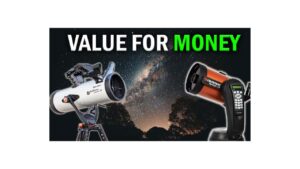
In one of the previous articles, we saw the difference between NexStar 8SE and Meade LX65 8-inch telescope. In this article, we will see the difference between NexStar 6SE and the Meade LX65 6 ACF. They both are 6-inch telescopes.
Type of Telescopes
Optical Tube
Both of these telescopes are for entry to the intermediate levels of astronomers. NexStar 6SE is a Schmidt-Cassegrain type telescope while Meade LX65 6 ACF is a Maksutov-Cassegrain type telescope. They both have an aperture of 150mm. The focal length of 6SE is 1500mm with a focal ratio of 10. The LX65 has a focal length of 1800mm with a focal ratio of 12.
Eyepieces
Both of them come with a 25mm plössl eyepiece and have a red dot viewfinder technology. The optical tube dimensions are a little different in both telescopes. 6SE has a length of 16-inches while LX65 has a length of 18-inches.

The weight of the telescope is also different for both of them. The 6SE weighs around 10kg when it is fully assembled. However, the LX65 weighs more than 6SE when assembled. In LX65 the weight of the optical tube is 6kg.
Mount
Both of these telescopes have a single fork alt-azimuth mount. Celestron’s mount can carry a weight of up to 5kg. However, LX65’s mount has two Vixen-style dovetail saddles that allow you to mount 2 telescopes at the same time. One is your main primary telescope and the second is for a camera rig or smaller secondary telescope. Overall the mount payload capacity of this telescope is 10 kg, but you shouldn’t put all 10kg payloads on one side of the mount. The primary payload capacity is 6.8kg and the secondary payload capacity is 3.2 kg.
This is very convenient for astrophotography or if you want the wide-field perspective and zoomed-in perspective at the same time. NexStar’s mount comes with a database of about 40,000 celestial objects while LX65’s mount comes with a database of 30,000 celestial objects. The brain of the LX65 is the venerable Audio-Star computer controller technology. The Audio-Star user interface has features such as guided tours, extended information on popular objects, and multiple alignment options. It also has a built-in speaker with which you can listen to a narration about what you are looking at through your telescope.


What you can see with these telescopes?
With both telescopes, you can see objects in our solar system, star clusters, nebulae & galaxies. However, if you are observing planets with LX65 then it will perform better than 6SE. LX65 has a slightly longer focal length than 6SE, which will give you a little narrower view. This narrow view will not be much helpful in deep space stargazing but will help in observing planets in our solar system.

Which one should you buy?

While making this decision you need to know what you want to observe with your telescope. If you are someone who wants to observe planets in our solar system then LX65 will serve you better.
If you want to do both, such as observe our solar system and deep space objects then go with 6SE. Even if you go with the LX65 then you can get your wide-field view by mounting a secondary telescope. So LX65 has a plus point here, as you can use two telescopes at the same time. Also, as the LX65 mount has a greater payload capacity, it will be more stable compared to the 6SE mount. If you are someone who is a beginner then starting with Celestron is great, as it is very easy to set up and quite beginner-friendly.
Also, both of these are 6-inch aperture telescopes. If you are very serious about following your hobby for the long term then eventually you will be in the market shopping for a bigger telescope.
So, if you can stretch your budget, then you should consider buying an 8-inch telescope from either of these brands. But if you do not have a budget or you are not sure about following this hobby for the long term then both of these 6-inch telescopes will serve you better according to your purpose.
We hope this article helped you to understand the difference between these two telescopes to make a better buying decision. If you like our content then please share it with someone who is interested in astronomy, stargazing, and space technology.
NexStar 6SE | MEADE LX65 6ACF | |
Aperture | 150mm (5.91″) | 152mm (6”) |
Focal Length | 1500mm | 1524mm |
Focal Ratio | f/10 | f/10 |
Optical Design | Schmidt-Cassegrain | Catadioptric |
Weight | 21 lbs (9.5 kg) | 12.755 lb(5.78kg) |
What can you see | Encke Division in Saturn’s rings, | Moon, planets, Nebulae, star clusters |
Price |





